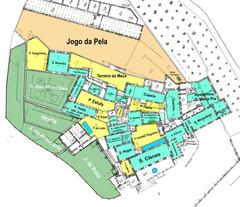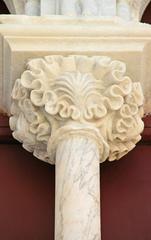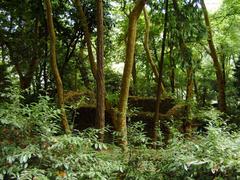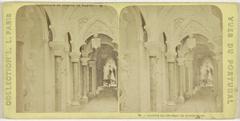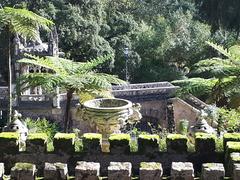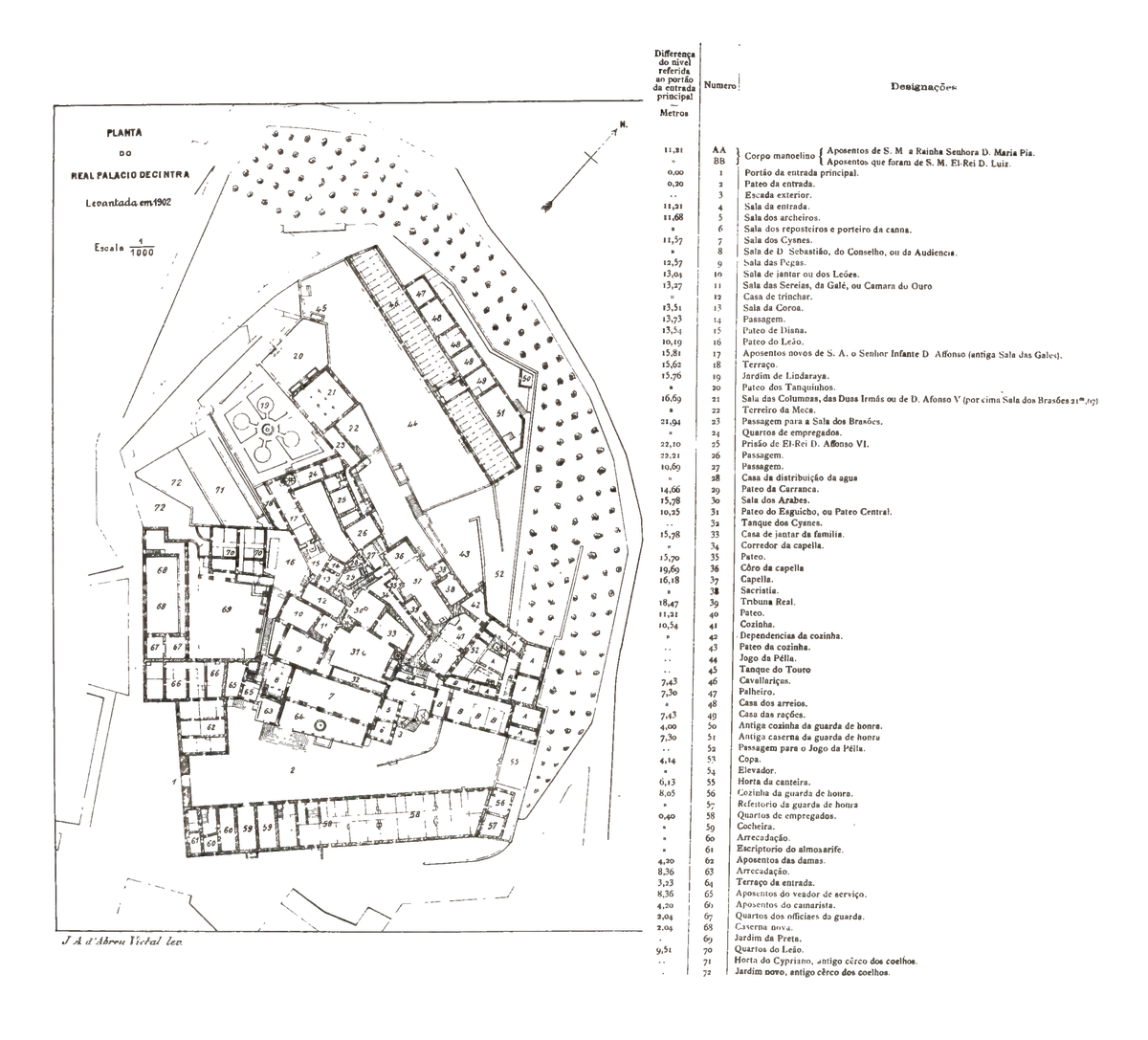
Palácio Nacional de Sintra Visitor Guide
Date: 16/07/2024
Introduction
The Palácio Nacional de Sintra, located in the picturesque town of Sintra, Portugal, is a remarkable testament to the country’s rich historical and architectural heritage. Often referred to as the Sintra National Palace, this iconic site has captivated visitors for centuries with its unique blend of Moorish, Gothic, Manueline, and Renaissance styles. Its origins can be traced back to the early medieval period when it served as a Moorish palace. Over the centuries, it has evolved and expanded under various Portuguese monarchs, becoming a symbol of royal grandeur and artistic patronage. The palace’s significance is further underscored by its designation as a UNESCO World Heritage Site in 1995, which acknowledges its global cultural and historical importance (UNESCO World Heritage). This comprehensive guide aims to provide an in-depth exploration of the Palácio Nacional de Sintra, covering its rich history, architectural marvels, visitor information, and nearby attractions. Whether you’re planning a visit or simply seeking to learn more, this guide offers valuable insights into one of Portugal’s most cherished landmarks.
Table of Contents
- Introduction
- History of Palácio Nacional de Sintra
- Modern Era and UNESCO Recognition
- Architectural Highlights
- Visitor Tips
- Nearby Attractions and Travel Tips
- FAQ
- Conclusion
History of Palácio Nacional de Sintra
Early Beginnings and Moorish Influence
The Palácio Nacional de Sintra’s history dates back to the early medieval period, originally hosting a Moorish palace constructed during the Islamic rule of the Iberian Peninsula. The Moors, who controlled the region from the 8th to the 12th century, left a significant architectural and cultural imprint on the palace. The earliest recorded mention of the palace dates to the 10th century, during the reign of the Moorish governor of Lisbon, who used it as a summer residence.
Reconquista and the Birth of the Royal Palace
The Reconquista, the Christian reconquest of the Iberian Peninsula, culminated in the capture of Sintra by King Afonso I of Portugal in 1147. The palace was subsequently repurposed and expanded by the Portuguese monarchy. King Dinis I (1261-1325) is credited with initiating the transformation of the Moorish structure into a royal residence, laying the foundation for what would become a significant symbol of Portuguese royalty.
Manueline and Gothic Architectural Flourishes
Notable expansions and renovations occurred during the reign of King João I (1357-1433) and his successor, King Manuel I (1469-1521). King João I commissioned the construction of the iconic conical chimneys, a defining feature of the palace’s silhouette, designed to accommodate large-scale royal feasts.
King Manuel I, known for his patronage of the arts and architecture, introduced the Manueline style to the palace. This architectural style, unique to Portugal, is characterized by intricate stonework, maritime motifs, and elements inspired by the Age of Discoveries. The Manueline Wing, added during his reign, includes the stunning Sala dos Brasões (Coats of Arms Room), adorned with the coats of arms of 72 noble families.
The Renaissance and Baroque Periods
The Renaissance period saw further embellishments to the palace, particularly under the reign of King João III (1502-1557). The palace’s interior was enriched with azulejos (decorative ceramic tiles), frescoes, and ornate wooden ceilings. The influence of the Italian Renaissance is evident in the harmonious proportions and classical elements introduced during this period.
The Baroque era brought additional modifications, particularly during the reign of King Pedro II (1648-1706). The palace’s chapel, dedicated to Saint Peter, was renovated in the Baroque style, featuring gilded woodwork and elaborate altarpieces, reflecting the evolving tastes and artistic trends of the Portuguese court.
Decline and Restoration
The 18th and 19th centuries witnessed a decline in the palace’s prominence as a royal residence. The devastating earthquake of 1755, which ravaged Lisbon and its surroundings, caused significant damage to the palace. Although it was partially restored, the palace fell into relative disuse.
The 19th century saw a revival of interest in the palace, spurred by the Romantic movement and the efforts of King Ferdinand II (1816-1885). Known as the “Artist King,” Ferdinand II undertook extensive restoration projects, preserving the palace’s historical and architectural integrity, ensuring that the Palácio Nacional de Sintra remained a cherished symbol of Portugal’s royal heritage.
Modern Era and UNESCO Recognition
In the 20th century, the Palácio Nacional de Sintra transitioned from a royal residence to a public museum. The Portuguese government undertook significant restoration efforts to preserve the palace’s historical and architectural legacy. In 1995, the palace, along with the surrounding cultural landscape of Sintra, was designated a UNESCO World Heritage Site. This recognition underscores the palace’s global significance as a cultural and historical landmark.
Architectural Highlights
The Swan Room (Sala dos Cisnes)
One of the palace’s most iconic rooms, the Swan Room, features a stunning ceiling adorned with painted swans. This room, used for royal banquets and receptions, exemplifies the blend of Gothic and Manueline styles that characterize the palace.
The Magpie Room (Sala das Pegas)
The Magpie Room is another notable space, named for the magpies painted on its ceiling. Each magpie holds a scroll with the phrase “Por bem” (For good), a reference to a legend involving King João I and his court.
The Arab Room (Sala dos Árabes)
Reflecting the palace’s Moorish origins, the Arab Room features intricate stucco work and geometric patterns. This room serves as a reminder of the palace’s diverse cultural influences.
Visitor Tips
Opening Hours
The palace is open daily, with extended hours during the summer months. It is advisable to check the official Parques de Sintra website for the most current information.
Tickets
Tickets can be purchased online or at the entrance. Consider buying a combined ticket that includes other attractions in Sintra for a more comprehensive experience. Ticket prices generally range from €10 to €14, but discounts are available for students, seniors, and children.
Guided Tours
Guided tours are available and provide valuable insights into the palace’s history and architecture. Tours can be booked in advance through the official Parques de Sintra website or at the entrance.
Accessibility
The palace has made efforts to accommodate visitors with mobility issues, but some areas may still be challenging to access. Wheelchairs are available upon request.
Photography
Photography is allowed in most areas of the palace, but the use of flash is prohibited to protect the delicate artworks. Remember to check specific signage for restrictions.
Nearby Attractions and Travel Tips
Quinta da Regaleira
A short distance from the palace, this estate is famous for its mystical gardens and underground tunnels. More information can be found on the Quinta da Regaleira website.
Pena Palace
Another stunning palace in Sintra, known for its bright colors and eclectic architecture. Visit the Pena Palace website for details.
Sintra-Cascais Natural Park
Ideal for nature enthusiasts, offering hiking trails and breathtaking views. Explore more on the Sintra-Cascais Natural Park page.
Travel Tips
Sintra is accessible by train from Lisbon, with frequent services running throughout the day. Consider arriving early to avoid crowds, especially during peak tourist season.
FAQ
- What are the opening hours of Palácio Nacional de Sintra? The palace is open daily, with extended hours in the summer. Check the official website for the most current information.
- How much are tickets for Palácio Nacional de Sintra? Ticket prices generally range from €10 to €14, with discounts available for students, seniors, and children. Combined tickets with other Sintra attractions are also available.
- Is the Palácio Nacional de Sintra accessible for visitors with mobility issues? The palace has made efforts to improve accessibility, but some areas may still be challenging. Wheelchairs are available upon request.
Conclusion
The Palácio Nacional de Sintra stands as a beacon of Portugal’s illustrious past, offering a unique window into the country’s royal and architectural heritage. From its early Moorish beginnings to its transformation into a royal residence, the palace has witnessed significant historical events and cultural shifts. Today, it continues to enchant visitors with its stunning architectural features, including the iconic conical chimneys and the richly decorated rooms that reflect a blend of Gothic, Manueline, and Renaissance styles. As a UNESCO World Heritage Site, the palace not only preserves its historical integrity but also serves as a cultural hub, hosting a variety of events and exhibitions that enrich the visitor experience (Parques de Sintra). A visit to the Palácio Nacional de Sintra is more than just a tour of a historical monument; it is a journey through time that offers a deeper understanding of Portugal’s royal heritage and architectural innovation. Whether you are a history enthusiast, an architecture aficionado, or simply a curious traveler, the palace offers an unforgettable experience that highlights the beauty and complexity of Portuguese culture. Plan your visit today to explore the many treasures of the Palácio Nacional de Sintra and immerse yourself in the rich history and stunning beauty of this iconic landmark.
References
- Sintra National Palace. (n.d.). Parques de Sintra. Retrieved July 16, 2024, from https://www.parquesdesintra.pt/en/parks-monuments/national-palace-of-sintra/
- UNESCO World Heritage. (n.d.). Cultural Landscape of Sintra. Retrieved July 16, 2024, from https://whc.unesco.org/en/list/723/
- Architectural Digest. (n.d.). Sintra, Portugal. Retrieved July 16, 2024, from https://www.architecturaldigest.com/story/sintra-portugal
- Azulejos. (n.d.). The History of Azulejos. Retrieved July 16, 2024, from https://www.azulejos.pt/en/
- Portugal Heritage. (n.d.). National Palace of Sintra. Retrieved July 16, 2024, from https://www.visitportugal.com/en/content/national-palace-sintra
- Sintra Gardens. (n.d.). Park and Palace of Monserrate. Retrieved July 16, 2024, from https://www.parquesdesintra.pt/en/parks-monuments/park-and-palace-of-monserrate/
- Visit Portugal. (n.d.). Sintra. Retrieved July 16, 2024, from https://www.visitportugal.com/en/destinos/lisboa-regiao/73833

